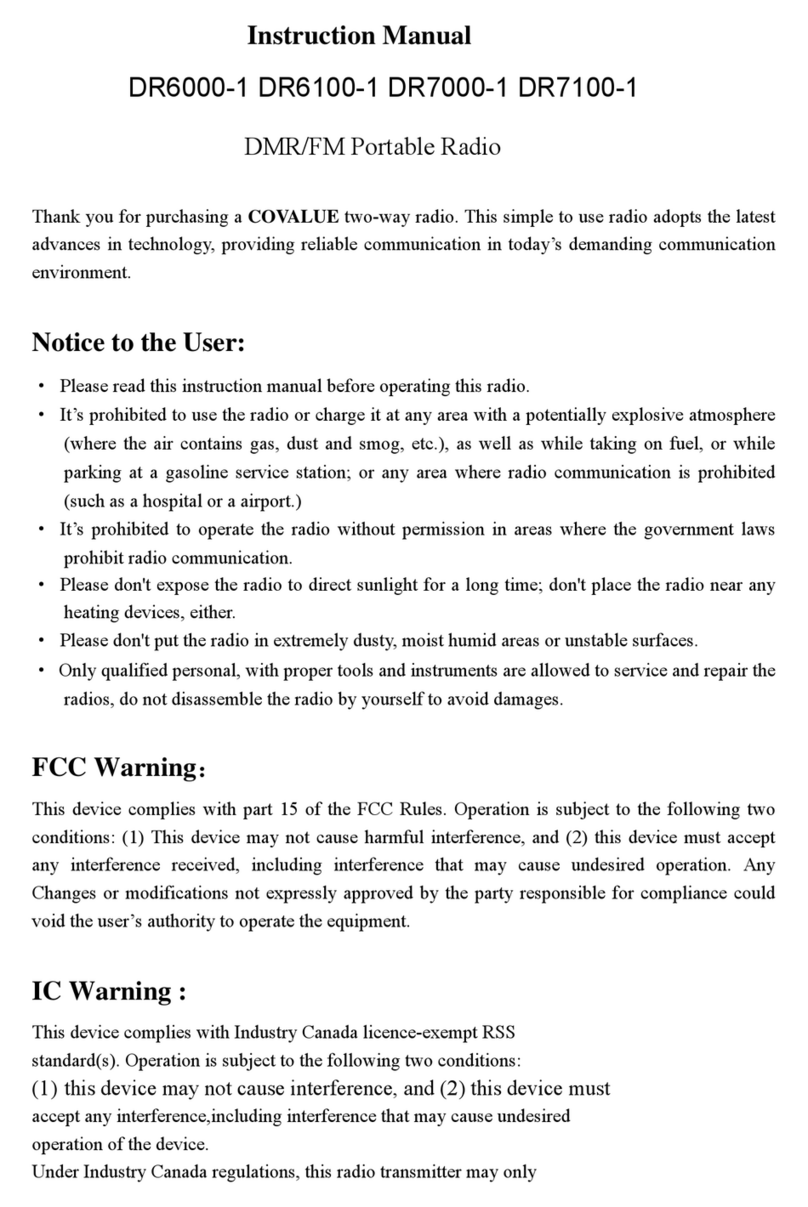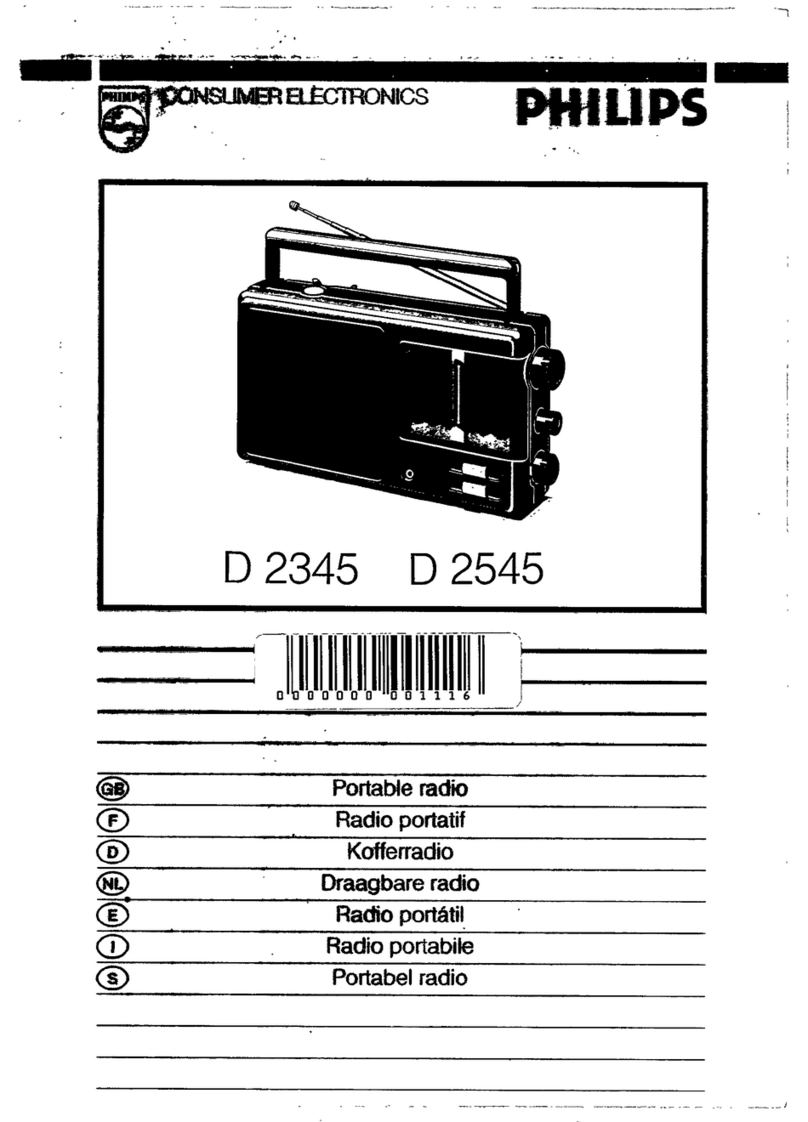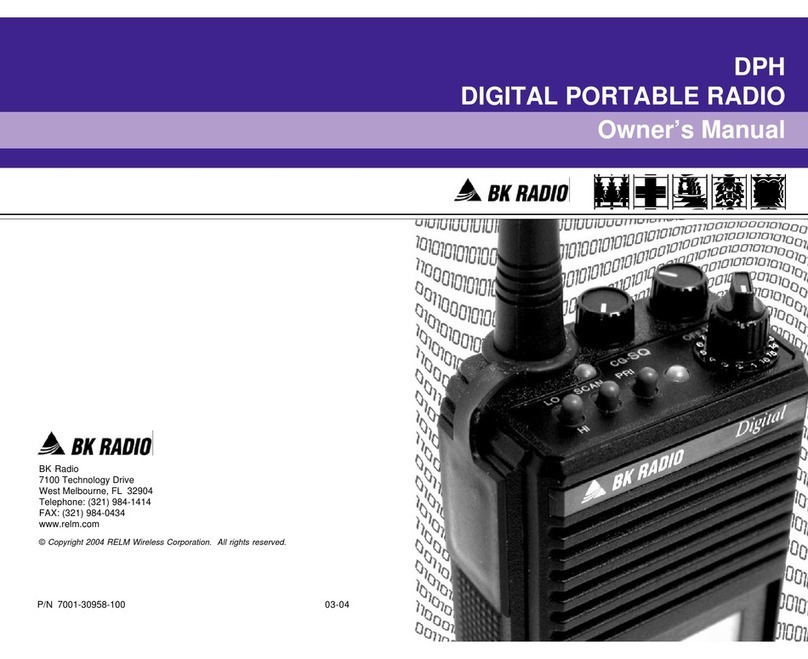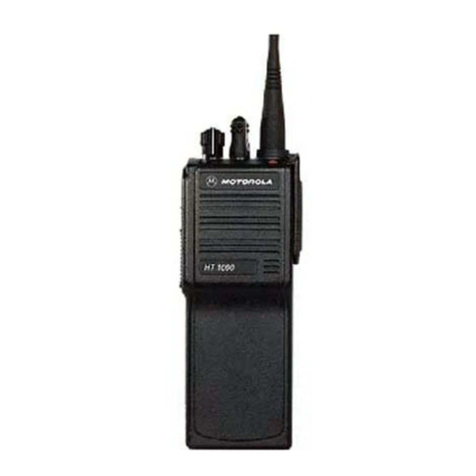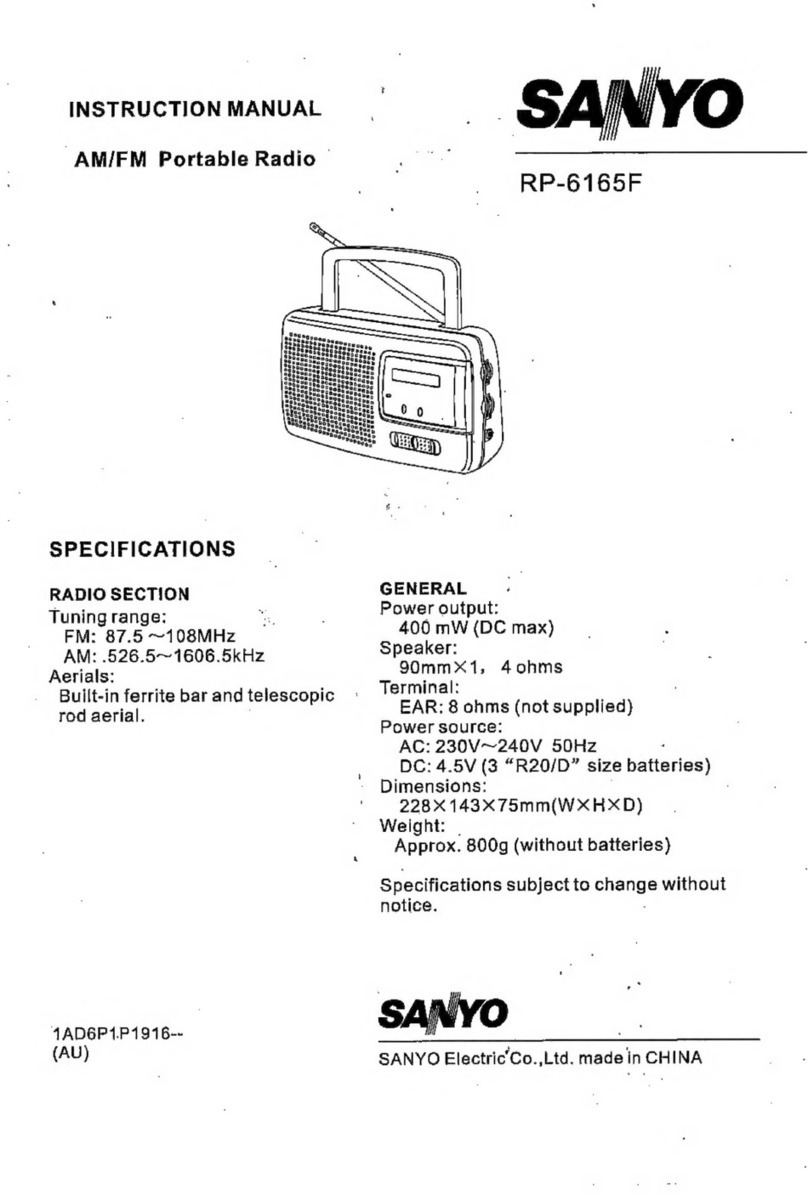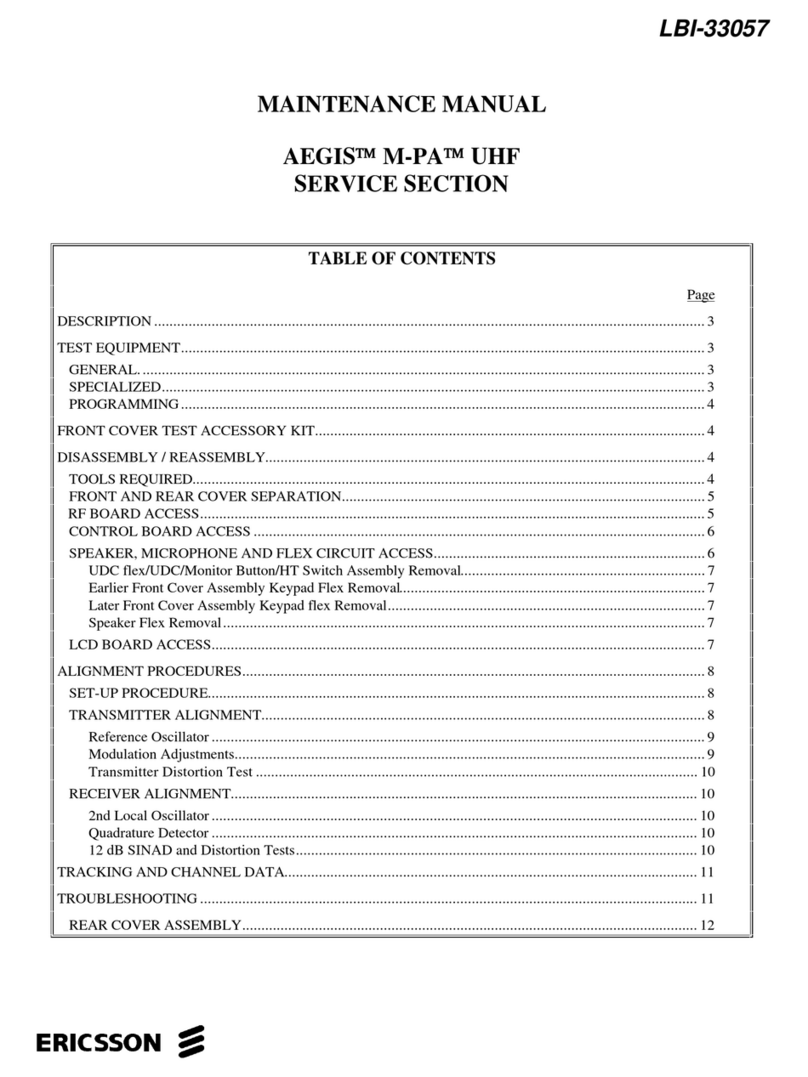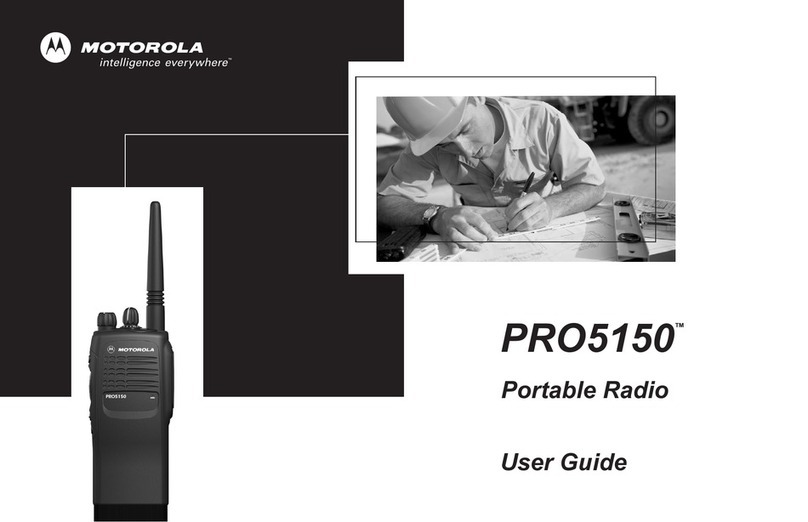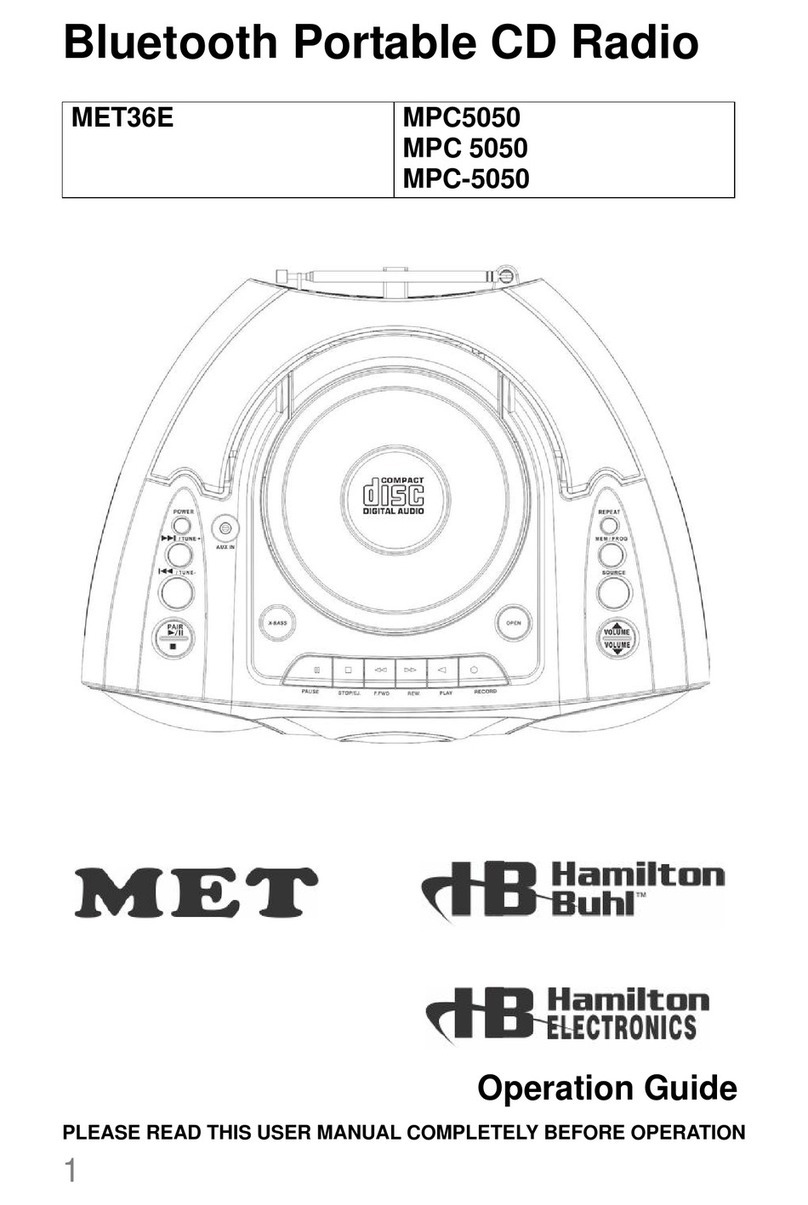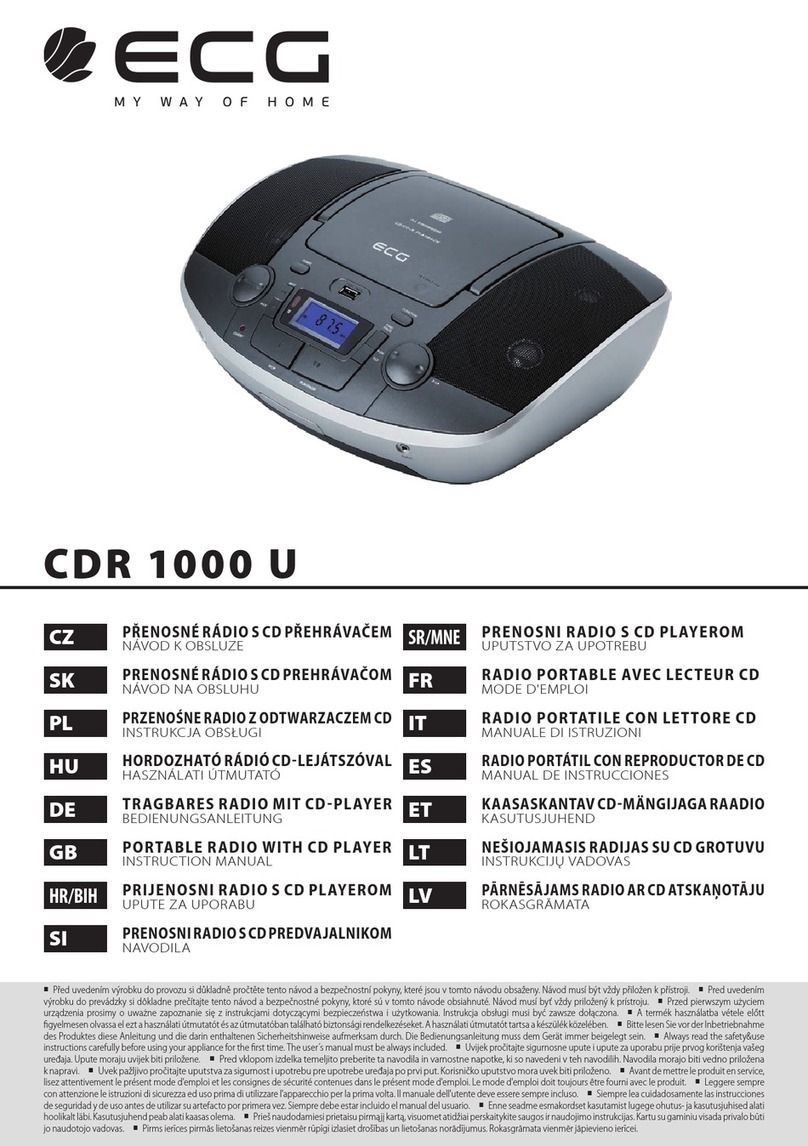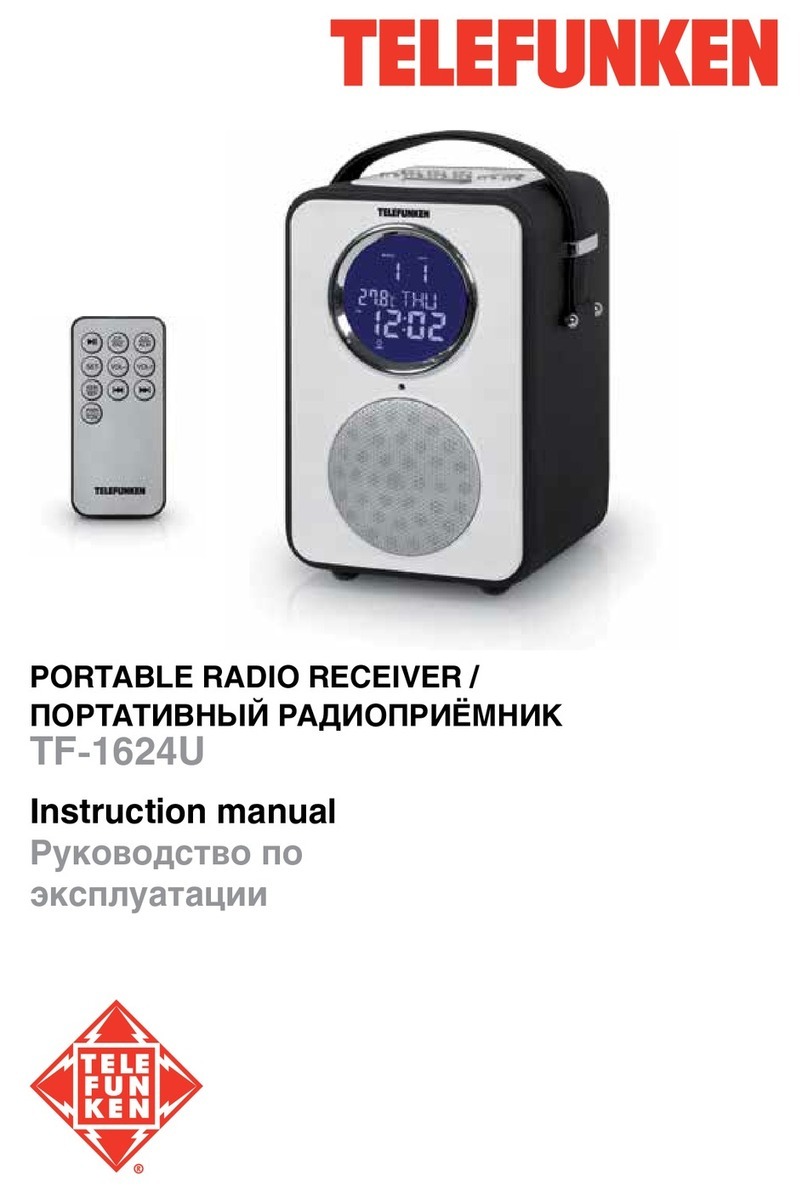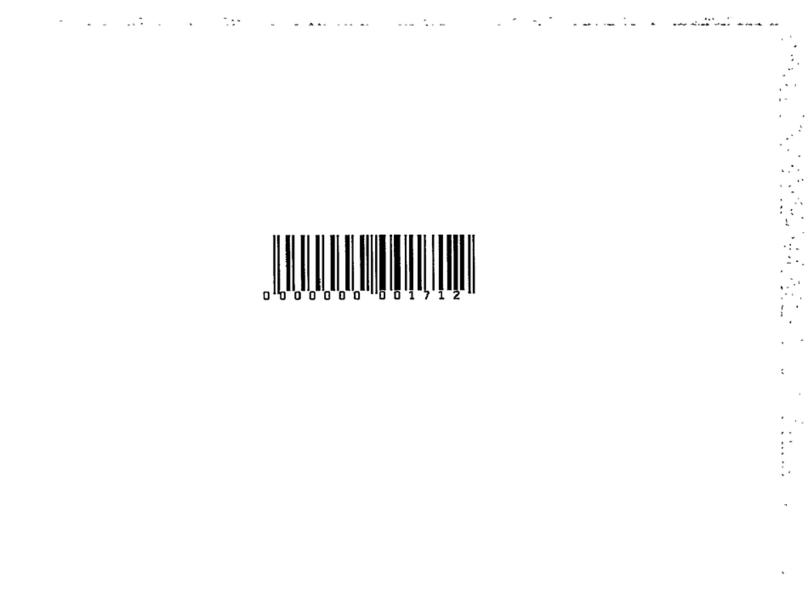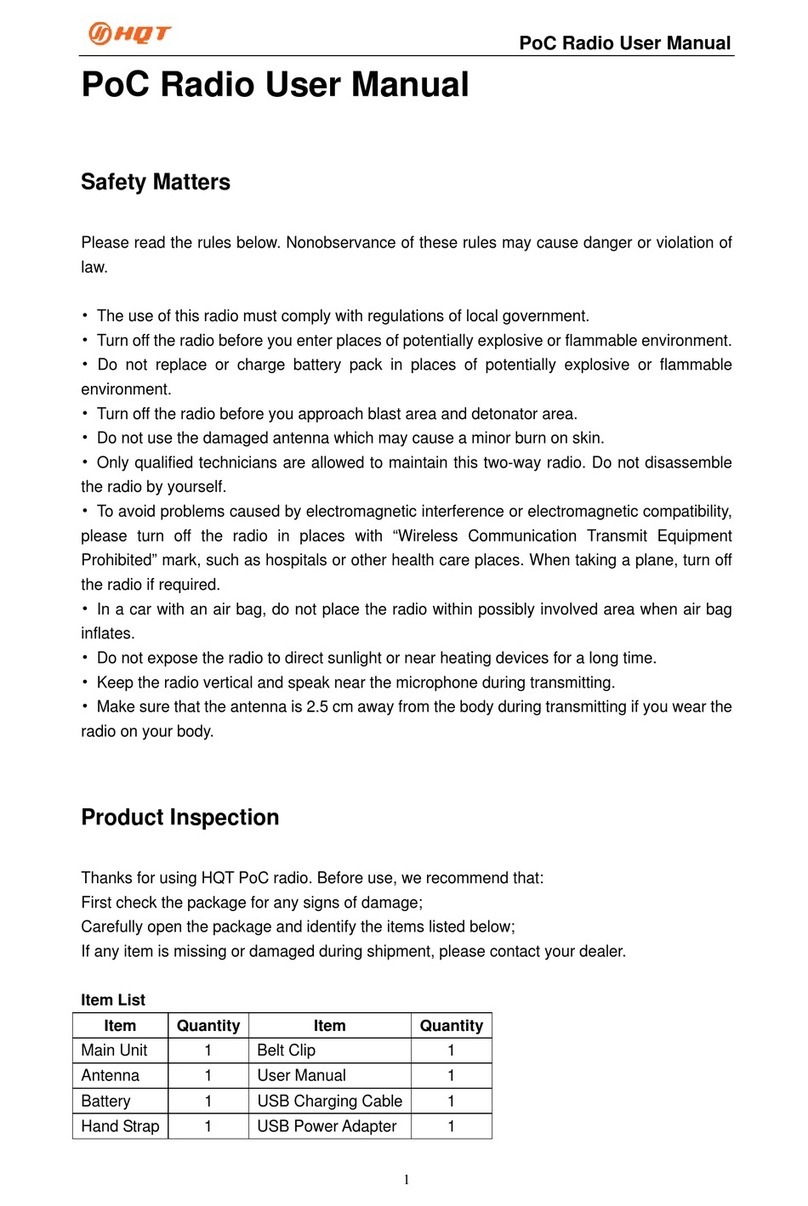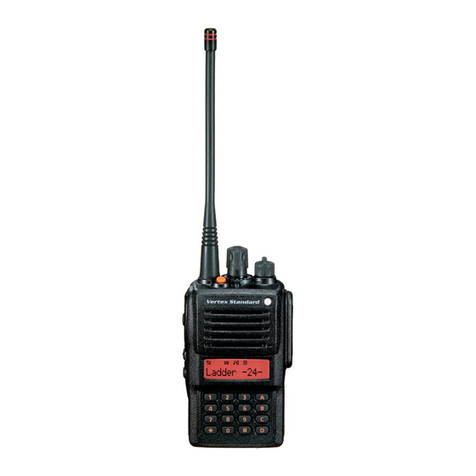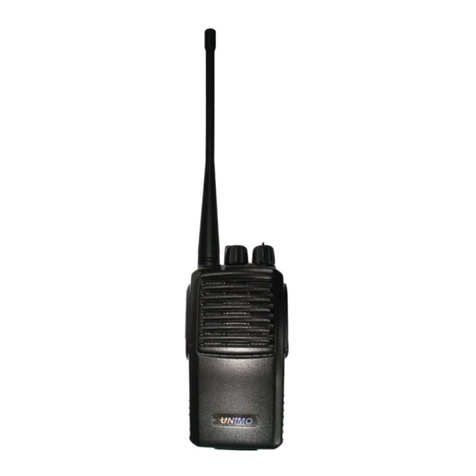Crystal DBH11R User manual

!! !!!!!!!User!Manual!
!
!!!!!DBH11R!–!80!Channel!1!Watt!UHF!Hand!held!!
!!

INTRODUCTION
Thank you for purchasing this CRYSTAL CB Radio. Please ensure that you have read the
product manual and instructions in full, prior to installation and use. Failure to do so may
result in product failure/damage or incorrect operation and therefore impact the product
performance.
There are many government rules and regulations surrounding the use of UHF radio so
please familiarise yourself with local legislation and the safety information contained within
this product manual before use.
BOX CONTENTS
Parts supplied include:
2 x Hand held UHF radios
2 x Rechargeable batteries
2 x Belt clips
2 x Interchangeable covers
1 x Twin charging dock
1 x 240V Adapter
SAFETY INFORMATION AND WARNINGS
Information on Safe Operation
Read This Information Before Using Your CRYSTAL Radio. The operation of your UHF
radio in Australia is subject to conditions in the following license: In Australia the ACMA
Radio communications (Citizen Band Radio Stations) and in New Zealand by MED the
General User Radio License for Citizen Band Radio.
Radio Antenna
Do not use any radio that has a damaged antenna. If a damaged antenna comes in
contact with the skin, a minor burn may result. Unauthorized antennas, modifications, or
attachments could damage the radio and violate compliance. Do NOT change or modify
the antenna.
Do NOT hold the antenna when the radio is “IN USE.” Holding the antenna reduces range
and may cause bodily harm.
Safety and general use whilst in a vehicle
Check the State and Federal laws and regulations regarding the use of two-way radios in
the area where you drive, and always obey them.
For Vehicles fitted with Airbags
Do not place your radio in the area over an air bag or in the air bag deployment area. Air
bags inflate with great force. If a radio is placed in the air bag deployment area and the air
bag inflates, the radio may be propelled with great force and cause serious injury to the
occupants of the vehicle

Batteries
All batteries can cause property damage and/or bodily injury such as burns if conductive
material such as jewellery, keys, or beaded chains touches exposed terminals. The
material may complete an electrical circuit (short circuit) and become quite hot. Exercise
care in handling any charged battery, particularly when placing it inside a pocket, purse, or
other container with metal objects.
Do not replace or charge batteries in a potentially explosive atmosphere. Contact sparking
may occur while installing or removing batteries and cause an explosion.
Potentially Explosive Atmospheres
Turn your radio OFF when in any area with a potentially explosive atmosphere. Sparks in
such areas could cause an explosion or fire resulting in injury or even death. NOTE: Areas
with potentially explosive atmospheres are often, but not always clearly marked. They
include fuelling areas such as below deck on boats; fuel or chemical transfer or storage
facilities; areas where the air contains chemicals or particles, such as grain, dust, or metal
powders; and any other area where you would normally be advised to turn off your vehicle
engine.
Exposure to Radio Frequency Energy
Your CRYSTAL two-way radio complies with Australian Communications Authority Radio
communications (Electromagnetic Radiation-Human Exposure) Standard, 2003. To assure
optimal radio performance and make sure human exposure to radio frequency
electromagnetic energy is within the guidelines set out in the above standards always
adhere to the following procedures.
Transmit and Receive Procedure
Your two-way radio contains a transmitter and a receiver. To control your exposure and
ensure compliance with the general population/uncontrolled environment exposure limits,
always adhere to the following procedure: • Transmit no more than 50% of the time.
• To receive calls, release the PTT button.
• To transmit (talk), press the Push to Talk (PTT) button.
Transmitting 50% of the time, or less, is important because the radio generates
measurable RF energy exposure only when transmitting (in terms of measuring standards
compliance). Always hold the radio approximately 5cm in front of your mouth with the
antenna pointing away from your head.
Radio Operation and EME Exposure
Unauthorized antennas, modifications, or attachments could damage the radio and violate
compliance. Do NOT hold the antenna when the radio is “IN USE.” Holding the antenna
reduces the effective range. Do not use the radio if the antenna is damaged. If a damaged
antenna makes contact with your skin, a minor burn can result. If you wear a radio on your
body when transmitting, always fit the radio on the belt clip (supplied). Always ensure the
radio and it's antenna are at least 5cm from your body when transmitting.
Electromagnetic Interference/Compatibility
Nearly every electronic device is susceptible to electromagnetic interference (EMI). To
avoid the possibility of electromagnetic interference and/or compatibility conflicts, turn off
your radio in any location where posted notices instruct you to do so such as health care
facilities.

Aircraft
When instructed to do so, turn off your radio when onboard an aircraft. Any use of a radio
must be in accordance with applicable regulations per airline crew instructions.
Medical Devices – Pacemakers
The Advanced Medical Technology Association recommends that a minimum separation
of 6 inches (15cm) be maintained between a handheld wireless radio and a pacemaker.
These recommendations are consistent with the independent research by and
recommendations of the U.S. Food and Drug Administration.
People with pacemakers should:
• ALWAYS keep the radio more than 15cm from their pacemaker when the radio is turned
ON.
• Not carry the radio in the breast pocket.
• Use the ear opposite the pacemaker to minimize the potential for interference.
• Turn the radio OFF immediately if there is any reason to suspect that interference is
taking place.
Medical Devices -Hearing Aids
Some radios may interfere with some hearing aids. In the event of such interference, you
may want to consult your hearing aid manufacturer to discuss alternatives.
Other Medical Devices
If you use any other personal medical device, consult the manufacturer of your device to
determine if it is adequately shielded from RF energy. Your physician may be able to
assist you in obtaining this information.
General warnings
Never use your radio outdoors during a thunderstorm. Keep the radio out of reach of
babies and young children.
INSTALLING THE BATTERY & BELT CLIP
Belt clip
The supplied belt clip simply slides into the back of the main radio and clicks in place to
lock.
Battery pack
Your unit comes with a rechargeable battery pack. Also included, is a desktop charger.
The desktop charger will only charge the battery pack provided and not other types of
rechargeable batteries. If fitted, remove the belt clip by lifting the top tab away from the
main unit and slide the belt clip up. Slide the battery cover down approximately 5mm, then
lift away the cover. Insert the battery making sure the batteries label is facing outwards
with “up” at the top of the battery. Be sure to leave the batteries removal ribbon facing
outwards. Replace the battery cover ensuring the battery removal ribbon is laying flat
against the battery. If desired, replace the Belt clip.
!
!

FOR USE OF NON RECHARGEABLE BATTERIES:
!
Slide down the battery compartment cover. Insert 3 x AAA batteries (not supplied).
Position the batteries according to the polarity marking on the battery compartment.
After placing batteries into correct positions, replace the battery cover.!!
RADIO LAYOUT!
!
!
!
!
!
!
!
!
!
!
!
!
LCD DISPLAY ICONS

RADIO OPERATION
Turning unit on/off
1- Switching on
Press and hold the POWER/On/Off button until you hear a beep sound and the display will
light up.
2- Switching off
Press and hold the POWER/On/Off until you hear a beep sound and the display will turn
off.
Adjusting the Volume
You have 8 preset volume levels. They are displayed on the LCD screen. To raise the
volume press the up button and to decrease the volume, press the down button. Once the
desired volume level has been selected, press the Up & Down buttons and this will save
the selected volume and the radio will return to the default screen.
!
Changing Channels
You have a maximum of 80 channels at your disposal. To communicate with another
device, you must both be on the same channel.
Press the “(MENU) button”once the channel number on the display will start flashing.
Press the “Up & Down buttons” to scroll to the desired channel. Once the desired
channel has been selected, press the “(PTT)” button to confirm and this will save the
selected channel and the radio will return to the default screen with the new channel
displayed.
!
Your DBH11R is simplex “one way at a time”. While you are speaking, you cannot receive
a transmission. Your DBH11R is an open-license band. Always identify yourself when
transmitting on the same channel.
NOTE: Channels 05 and 35 are reserved for emergency use only.
Scanning
The scan feature will enable the radio to automatically scan through selected channels at
20 channels per 3 seconds.
To scan, press and hold the “(UP) button” for 3 seconds the unit will scan through all 80
channels. The word SCAN will appear in the top left of the screen to indicate it is scanning.
The direction of the scan can simply be changed by using the “UP button” or “DOWN
button”.
To stop scanning, press the “(PTT) button” or press the “UP button” again and the radio
will go back to the original channel set before scanning.
The user can still transmit on the selected channel at anytime by pressing the “(PTT)
button” on the radio, once the transmission is complete the radio will continue scanning
after 20 seconds.
IMPORTANT:!Before transmitting on a UHF channel listen to ensure it is not already in
use.!

!
Transmitting (sending speech)
The unit is continuously in the Receive mode when the unit is turned ON and not
transmitting. When a signal is received on the current channel, “RX” ic on will be displayed
on the LCD screen. a. Press and hold the (PTT) button (Push to Talk) button to transmit
your voice. The transmit signal icon “TX” will display on the LCD screen. b. Hold the unit
in a vertical position with the Mic (Microphone) 5 cm away from the mouth. While holding
the (PTT) button, speak into the microphone in a normal tone of voice. c. Release the
(PTT) button when you have finished transmitting.
For others to receive your transmission, they must be on the same channel as you.!!
Keypad lock
Press and hold the “(MENU) button” for 3 seconds to lock the keypad. A small key
symbol will appear under the channel number to indicate the keypad is locked. The “(PTT)
button” will still function in this mode. To unlock the keypad, press and hold the “(MENU)
button” for 3 seconds. The small key symbol will now disappear from the display and the
keypad will be functional.
Squelch control
The DBH11R has automatic squelch control, which silences the constant background
noise during periods of inactivity. The radio will still receive transmissions when a signal is
present, however it will eliminate background noise when a signal is not present.
To open the squelch (turn off automatic squelch control), press and hold down the
“(DOWN) button”, RX receive symbol will appear on the display and a constant static
noise can be heard. The radio is now allowing all signals to be heard.
Low Battery Meter Indicator
The radio can detect the low battery level when the battery voltage goes low. The battery
icon will display the low battery status. When battery voltage is low, the empty battery
symbol will appear and continue to blink. The battery symbol will continuously blink until it
totally drains the battery voltage where then you will have to recharge or replace the
batteries.
MAIN MENU
To access the main menu, while the radio is powered on, press the “(MENU) button.” To
navigate through each menu option, press the “(MENU) button” multiple times until the
desired feature is reached.
Menu options include:
1. Channel selection
2. CTCSS code settings
3. Voice operated exchange
4. Call tone
5. Key tone feature
6. Roger beep
7. Repeat

NOTE: Duplex Mode also known as Repeater is only available/displayed on selected
channels
(1-8 and 41-48). It will not display on the menu as an option when the radio is on another
channel
To exit the menu press the “(PTT) button” and the default channel screen will reappear,
this will also save any settings you changed. Alternatively, do not press any buttons for 8
seconds and the radio will automatically exit the menu and automatically save any
changed settings.
What is CTCSS
CTCSS (Continuous Tone-Coded Squelch System) modifies the transmission signal to
allow multiple users to share the same channel without disturbing each other. This is an
important feature on a radio when there are many radio users in the same area.
CTCSS continuously superimposes any one of about 50 low-pitch audio tones on the
transmitted signal, ranging from 67 to 254 Hz. When CTCSS is enabled, incoming signals
must be on the same CTCSS sub channel as the receiving radio or they will be filtered out.!
Setting CTCSS function
Press the “(MENU/PWR) button” twice, the CTCSS channel number on the LCD will start
flashing.
To enable CTCSS, press the “UP button” or “DOWN button” until CTCSS appears on
the screen, channel selection can be made between 1-38. Once the desired setting is
selected, press the “(MENU) button” to save the setting. The unit will automatically
change back to the default screen with the CTCSS sub channel now on display.
To turn off CTCSS, press the “UP button” or “DOWN button” until “0F” appears. Press
the “(MENU) button” to save the setting. The unit will automatically
change back to the default screen and CTCSS will turn off.
FUNCTION- VOX
What is VOX?
VOX stands for Voice Operated Exchange, the feature allows a user to transmit simply by
talking into the radio without having to press the (PTT) BUTTON.
Setting VOX Mode
To access VOX mode, press the “(MENU) button” three times, VOX will display at the top
of the LCD. Press the “UP button” or “DOWN button” to select an option, “OFF-1-2-3” (1
is low voice sensitivity and will only pick up load noises, while 3 is high sensitivity and will
pick up soft noises). Once the desired option has been selected, press the “(PTT)
BUTTON” and this will save the selected channel and the radio will return to the default
screen with the “VOX” displayed at the top. When VOX is activated, every time the radio
detects a noise it will automatically transmit.
NOTE: The use of VOX is not recommended in environments where noise is present (wind
or general loud background noise).

FUNCTION-CALL TONE
What is Call Tone?
A call tone is a 2 second signal that is sent out from the radio to let other users know you
would like to talk to them. It is an alternative option from just speaking into the MIC to
make the user stand out. The DBH11R has 10 call tone options.
To transmit a call tone, quick press the “(PTT) button”.
NOTE: Legislation only allows the call tone to be used once per minute, if the call button is
pressed more than once in a minute, the radio simply will not resend the call tone again.
Setting Call Tone
Press the “(MENU) button” four times, CA will on the LCD. Press the “UP button” or
“DOWN button” to select an option, “1-10”. Once the desired option has been selected,
press the “(PTT) button and this will save the selected channel and the radio will return to
the default screen.
FUNCTION- KEY TONE (KO)
Setting Key Tone (KO)
To access the KO feature, press the “(MENU) button” five times, “KO” will display on the
screen. Press the “UP button” or “DOWN button” to turn on or off. Once the desired
option has been selected, press the “(PTT) button” and this will save the selected option
and the radio will return to the default screen.
FUNCTION- ROGER BEEP
What is Roger Beep?
When the PTT is released after transmission, the radio will send a short beep to indicate
the transmission has finished. This is known as a roger beep.
Setting Roger Beep
To access the roger beep feature, press the “(MENU) button” six times, “RO” will display
on the screen. Press the “UP button” or “DOWN button” to select an option “on or off”.
Once the desired option has been selected, press the “(PTT) button” and this will save
the selected option and the radio will return to the default screen.
FUNCTION- REPEAT
What is Repeat?
Repeater stations allow your CB radio to operate over a greater distance (where your CB
has Duplex mode). The radio has repeat as default on.
Selecting Repeat
To access the repeat feature, press the “(MENU) button” seven times, “RP” will display
on the screen. Press the “UP button” or “DOWN button” to select an option “on or off”.
Once the desired option has been selected, press the “(PTT) button” and this will save
the selected option and the radio will return to the default screen.

Channel 5 and 35 (paired for Duplex repeaters) are reserved as emergency channels and
should be used only in an emergency. CTCSS and DCS will not operate on channels 5
and 35.
A list of currently authorised channels can be obtained from the ACMA website in Australia
and the MED website in New Zealand. Channel 11 is a calling channel generally used to
call others and channel 40 is the customary road vehicle channel.
Once contact is established on the calling channel, both stations should move to another
unused “SIMPLEX” channel to allow others to use the calling channel. Channels 22 and 23
are for Telemetry and Telecommand use, voice communications are not allowed on these
channels by law. Channel 9 and above are the best choices for general use in Simplex
mode.

FUNCTION- USING THE UHF RADIO
Transmit & receive procedure
Your UHF radio contains a transmitter and receiver. To control your exposure and ensure
compliance with the general population/uncontrolled environment exposure limits, always
adhere to the following procedure:
Transmit no more than 50% of the time.
To receive calls, release the “(PTT) button” on the microphone handpiece.
To transmit (talk), press the “(PTT) button” on the microphone handpiece.
When powered on and not transmitting, the radio is always in receive mode. When a
signal is received an RX full antenna symbol will display on the screen, when transmitting
TX display on the LCD.
For others to receive your transmission, they must be on the same channel as you and if
CTCSS or DCS is enabled, the same sub channel must also be selected.
NOTE: Before transmitting on a UHF channel, always listen to ensure it is not already in
use.
NOTE: Transmitting 50% of the time, or less, is important because the radio generates
measurable RF energy exposure only when transmitting (in terms of measuring standards
compliance).
NOTE: Do not transmit between two radios that are less than 1.5m apart, otherwise you
may experience interference.
NOTE: The UHF radio is simplex “one way at a time”. While you are speaking, you cannot
receive a transmission.
NOTE: The UHF radio is an open licence band. Always identify yourself when transmitting.
TRANSMITTING RANGE
The transmitting range will depend on the antenna, terrain, surroundings and environment,
it will be affected by obstructions such as hills, buildings and foliage. The use of duplex
mode will extend the transmission range in areas where a repeater station is present.
Channel 5 and 35 (paired for Duplex repeaters) are reserved as emergency channels and
should be used only in an emergency.
CTCSS and DCS will not operate on channels 5 and 35.
A list of currently authorised channels can be obtained from the ACMA website in Australia
and the MED website in New Zealand. Channel 11 is a calling channel generally used to
call others and channel 40 is the customary road vehicle channel.
Once contact is established on the calling channel, both stations should move to another
unused “SIMPLEX” channel to allow others to use the calling channel.!Channels 22 and 23
are for Telemetry and Telecommand use, voice communications are not allowed on these
channels by law. Channel 9 and above are the best choices for general use in Simplex
mode.

!
Radio communications (Citizen Band Radio Stations) Class Licence 2002
No licence is required to own or operate this radio in Australia and New Zealand. The
Radio communications (Citizen Band Radio Stations) Class Licence 2002 contains the
technical parameters, operating requirements, conditions of licence and relevant standards
for Citizen Band (CB) radios. CB radios must comply with the class licence for their use to
be authorised under the class licence.
UHF channels and frequencies
IMPORTANT NOTE: The operation of your UHF radio in Australia and New Zealand is
subject to conditions in the following licenses: In Australia the ACMA Radio
communications (Citizen Band Radio Stations) and in New Zealand by MED the General
User Radio License for Citizen Band Radio.
!
Channel!and!Frequency!(MHz)!!Australia (80CHS)
!
!
Tx!
Rx!
!
!
Tx!
Rx!
Channel!
Freq!
Freq!
Channel!
Freq!
Freq!
!
MHZ!
MHZ!
!
!
MHZ!
MHZ!
01*!
476.4250!!
476.4250!!
21!
!
476.9250!!
476.9250!!
!
;!
476.4375!!
!
61**!
;!
;!
02*!
41*!
476.4500!!
476.4500!!
22*!
!
476.9500!!
476.9500!!
42*!
;!
476.4625!!
!
62**!
;!
;!
!
476.4750!!
476.4750!!
23*!
!
476.9750!!
476.9750!!
03*!
43*!
;!
476.4875!!
!
63**!
;!
;!
04*!
476.5000!!
476.5000!!
24!
!
477.0000!!
477.0000!!
!
;!
476.5125!!
!
64!
477.0125!!
477.0125!!
05*!
44*!
476.5250!!
476.5250!!
25!
!
477.0250!!
477.0250!!
45*!
;!
476.5375!!
!
65!
477.0375!!
477.0375!!
!
476.5500!!
476.5500!!
26!
!
477.0500!!
477.0500!!
06*!
46*!
;!
476.5625!!
!
66!
477.0625!!
477.0625!!
07*!
476.5725!!
476.5750!!
27!
!
477.0750!!
477.0750!!
!
;!
476.5875!!
!
67!
477.0875!!
477.0875!!
08*!
47*!
476.6000!!
476.6000!!
28!
!
477.1000!!
477.1000!!
48*!
;!
476.6125!!
!
68!
477.1125!!
477.1125!!
9!
!
476.6250!!
476.6250!!
29!
!
477.1250!!
477.1250!!

!
49!
476.6375!!
476.6375!!
!
69!
477.1375!!
477.1375!!
10!
476.6500!!
476.6500!!
30!
!
477.1500!!
477.1500!!
!
476.6625!!
476.6625!!
!
70!
477.1625!!
477.1625!!
11!
50!
476.6750!!
476.6750!!
31*!
!
477.1750!!
477.1750!!
51!
476.6875!!
476.6875!!
!
71*!
477.1875!!
;!
!
476.7000!!
476.7000!!
32*!
!
477.2000!!
477.2000!!
12!
52!
476.7125!!
476.7125!!
!
72*!
477.2125!!
;!
13!
476.7250!!
476.7250!!
33*!
!
477.2250!!
477.2250!!
!
476.7375!!
476.7375!!
!
73*!
477.2325!!
;!
14!
53!
476.7500!!
476.7500!!
34*!
!
477.2500!!
477.2500!!
54!
476.7625!!
476.7625!!
!
74*!
477.2625!!
;!
!
476.7750!!
476.7750!!
35*!
!
477.2750!!
477.2750!!
15!
55!
476.7875!!
476.7875!!
!
75*!
477.2875!!
;!
16!
476.8000!!
476.8000!!
36*!
!
477.3000!!
477.3000!!
!
476.8125!!
476.8125!!
!
76*!
477.3125!!
!
17!
56!
476.8250!!
476.8250!!
37*!
!
477.3250!!
477.3250!!
57!
476.8375!!
476.8375!!
!
77*!
477.3375!!
!
!
476.8500!!
476.8500!!
38*!
!
477.3500!!
477.3500!!
18!
58!
476.8625!!
476.8625!!
!
78*!
477.3625!!
!
19!
476.8750!!
476.8750!!
39!
!
477.3750!!
477.3750!!
!
476.8875!!
476.8875!!
!
79!
477.3875!!
477.3875!!
20!
59!
476.9000!!
476.9000!!
40!
!
477.4000!!
477.4000!!
!
60!
476.9125!!
476.9125!!
!
80!
477.4125!!
477.4125!!
!
Important note:
The operation of your UHF radio in Australia and New Zealand is subject to conditions in
the following licenses:
In Australia the ACMA radio communications (Citizen band radio stations) and in New
Zealand by MED the general user radio license for citizen band radio.
* The primary use for these channels is repeater operation using 750kHz offset. Channels
1-8 and 41-48 inclusive are used for mobile reception and channels 31-38 and 71-78 for
mobile transmission. In addition, any designated repeater channel maybe used for simplex
operation in areas where it is not used for repeater operation.
*Speech telephony shall be inhibited on these channels.

*At the time of production channels 61,62 and 63 are guard channels and are not
available for use.
A list for currently authorized channels can be obtained from the ACMA.
website in Australia and MED website in New Zealand. Channel 11 is a calling channel
generally used to call others and channel 40 is the customary road vehicle channel.
Once contact is established on the calling channel, both stations should move to another
unused “ SIMPLEX” channel to allow others to use the calling channel.
38 CTCSS CODE LIST
CODE!
Frequency(Hz)!
CODE!
Frequency(Hz)!
OFF!
OFF!
20!
131.8!
1!
67.0!!
21!
136.5!
2!
71.9!!
22!
141.3!
3!
74.4!!
23!
146.2!
4!
77.0!!
24!
151.4!
5!
79.7!!
25!
156.7!
6!
82.5!!
26!
162.2!
7!
85.4!!
27!
167.9!
8!
88.5!!
28!
173.8!
9!
91.5!!
29!
179.9!
10!
94.8!!
30!
186.2!
11!
97.4!!
31!
192.8!
12!
100.0!!
32!
203.5!
13!
103.5!!
33!
210.7!
14!
107.2!!
34!
218.1!
15!
110.9!!
35!
225.7!
16!
114.8!!
36!
233.6!
17!
118.8!!
37!
241.8!
18!
123.0!!
38!
250.3!
19!
127.3!!
!
!
Radio!communications!(Citizen!Band!Radio!Stations)!!
Technical Assistance
If you need assistance setting up or using your CRYSTAL product now or in the future, call
CRYSTAL Support.
Australia
TEL: 03 – 8587 8898
FAX: 03 – 8587 8866
Mon-Fri 9am – 5pm AEST
Please retain this user guide for future reference.
If you would like to download a digital copy of this manual, or other Crystal

manuals/software, please visit the http://crystalm.com.au/ website. This manual is
considered correct at time of printing but is subject to change. For latest manuals and
updates refer to the website.
!
!
! ! !!!CRYSTAL!MOBILES!WARRANTY!AGAINST!DEFECTS!
!
!
!
This warranty against manufacturing defects is given by TDJ Australia Pty Ltd ACN 006
385 191). Our contact details are set out in clause 2.7.
1. Consumer guarantee
1.1 Our goods come with guarantees that cannot be excluded under the Australian
Consumer Law. You are entitled to a replacement or refund for a major (description
according to Australian Consumer Laws) failure and compensation for any other
reasonably foreseeable (description according to Australian Consumer Laws) loss or
damage. You are also entitled to have the goods repaired or replaced if the goods fail to
meet manufacturers specifications and the failure does not amount to a major failure.
1.2 To the extent we are able, we exclude all other conditions, warranties and obligations
which would otherwise be implied.
2. Warranty against defects
2.1 This Warranty is in addition to and does not limit, exclude or restrict your rights under
the Competition and Consumer Act 2010 (Australia) or any other mandatory protection
laws that may apply. Consumer guarantees are a set of rules that apply to goods and
services purchased by consumers under the Australian Consumer Law (ACL).
These rules set out the circumstances under which a business is required to provide a
consumer with a remedy.
The consumer guarantees automatically apply regardless of any voluntary or extended
warranty given by a seller or manufacturer of goods and services, or if such a warranty
has expired.
2.2 We warrant our goods to be free from defects in materials and workmanship for the
warranty period from the date of original sale (or another period we agree to in writing).
Subject to our obligations under clause 1.2, we will at our option, either repair or replace
goods which we are satisfied do not meet manufacturers specifications. We warrant any
replacement parts for the remainder of the period of warranty for the goods into which
they are incorporated.
2.3 To the extent permitted by law, our sole liability for breach of a condition, warranty or
other obligation implied by law is limited (a) in the case of goods we supply, to any one
of the following as we decide - (i) the replacement of the goods or the supply of
equivalent goods; (ii) the repair of the goods; (iii) the cost of repairing the goods or of
acquiring equivalent goods; (b) in the case of services we supply, to any one of the
following as we decide – (i) the supplying of the services again; (ii) the cost of having

the services supplied again.
2.4 For repairs outside the warranty period, we warrant our repairs to be free from
defects in materials and workmanship for three months from the date of the original
repair. We agree to re-repair or replace (at our option) any materials or workmanship
which we are satisfied do not meet manufacturers specifications.
2.5 We warrant that we will perform services with reasonable care and skill and agree to
investigate any complaint regarding our services made in good faith. If we are satisfied
that the complaint is justified, and as our sole liability to you under this warranty (to the
extent permitted at law), we agree to supply those services again at no extra charge to
you.
2.6 To make a warranty claim you must before the end of the applicable warranty period,
at your own cost, return the goods you allege do not meet manufacturers specifications,
provide written details of the alleged defect, and give us an original or copy of the
purchase receipt,sales invoice or some other evidence showing details of the transaction.
2.7 Send your claim to: TDJ Australia PTY LTD. 78 Mills Road, Braeside Melbourne
Victoria 3195, Australia,
TEL: 03 8587 8898 FAX: 03 8587 8866
2.8 If we determine that your goods do not meet manufacturers specifications, we will
pay for the cost of returning the repaired or replaced goods to you. If we find your goods
meet manufacturers specifications and no major defect is found, we will contact you to
arrange the return of the goods at your expense.
3. What this warranty does not cover
3.1 This warranty will not apply in relation to: (a) goods modified or altered in any way;
(b) defects and damage caused by use with non Standard Communications products;
(c) repairs performed other than by our authorized service team; (d) defects or damage
resulting from misuse, accident, impact or neglect; (e) goods improperly installed or
used in a manner contrary to the relevant instruction manual; or (f) goods where the
serial number has been removed or made illegal.
4. Warranty period
4.1 We provide the following warranty on Crystal Mobile products. No repair or
replacement during the warranty period will renew or extend the warranty period past the
period from original date of purchase.
This products warranty period is 2 years from date of purchase
!
!
Table of contents
